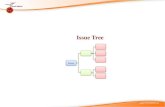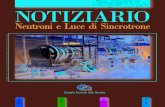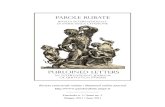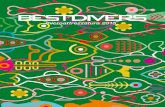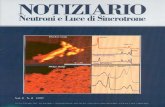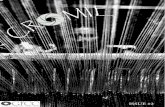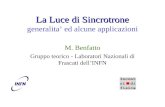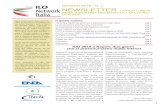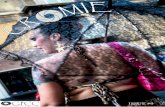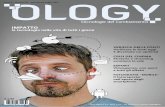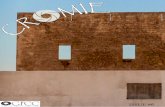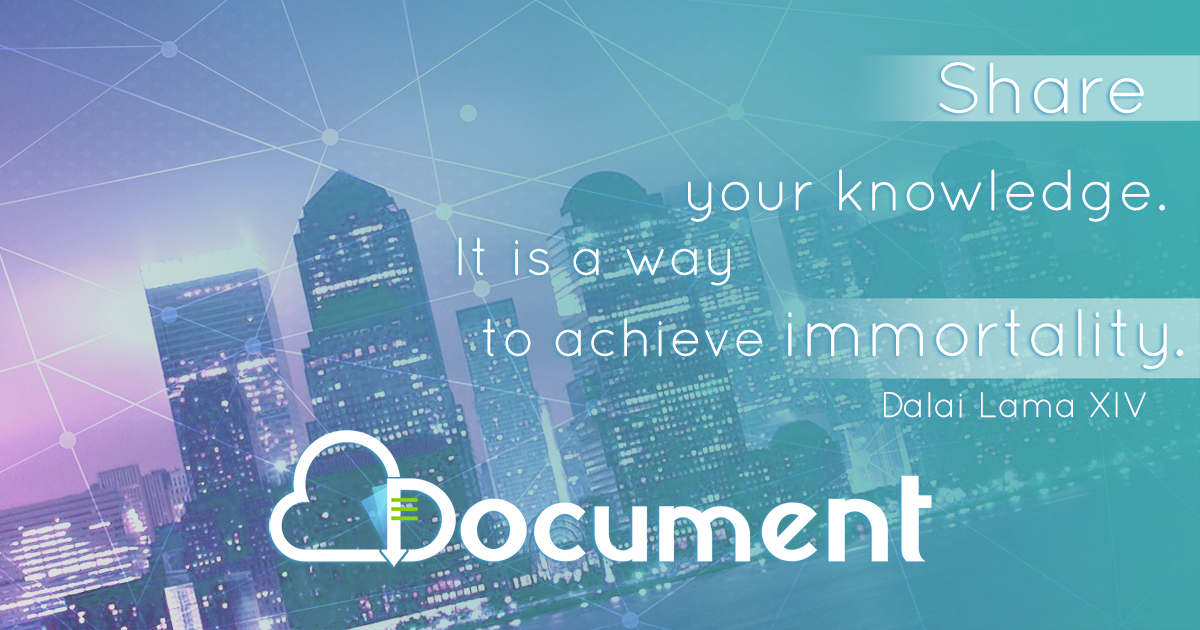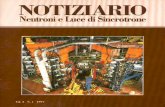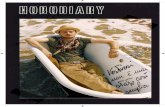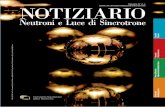NOTIZIARIO Neutroni e Luce di Sincrotrone - Issue 16 n.1, 2011
-
Upload
notiziario-nnls -
Category
Documents
-
view
218 -
download
1
description
Transcript of NOTIZIARIO Neutroni e Luce di Sincrotrone - Issue 16 n.1, 2011

ISSN
159
2-78
22 -
Vol.
16 n
. 1Ja
nuar
y 20
11 -
Aut.
Trib
. Rom
a n.
124
/96
del 2
2-03
-96
- Spe
d. A
bb. P
ost.
70%
Fili
ale
di R
oma
- C.N
.R. p
.le A
. Mor
o 7,
001
85 R
oma
Consiglio Nazionale delle Ricerche
Scie
ntifi
c Re
view
s
Infr
astr
uctu
res
M&
N&
SR N
ews
Scho
ol –
Mee
ting
www.cnr.it/neutronielucedisincrotroneConsiglio Nazionale delle Ricerche
Scientific ReviewsIn situ study of the water dynamics in a fuel cell Nafion membrane upon workingV. Rossi Albertini, B. Paci
Research InfrastructuresSincrotrone Trieste: launch of the new trigeneration plantL.B. Palatini
NFFA: Nanoscience Foundries and Fine AnalysisG. Rossi, R. Ciancio, C. Africh, R. Gotter, G. Panaccione,R. Ferranti, D. Orani, E. Lora Tamayo, L. Fonseca, J. Gobrecht,C. David, J. Greenhalgh, G. Arthur, E. Huq, P. Laggner,H. Amenitsch, K. Jungnikl, B. Sartori
Muon & Neutron & Synchrotron Radiation NewsNews from SNS Neutron Instruments Added at Oak RidgeA.E. Ekkebus
School and Meeting ReportsWorkshop on High-Energy Neutrons for Science and SocietyC. Andreani, N. Gidopoulos
Scattering and Imaging with eV Neutrons:X School of Neutron Scattering Francesco Paolo RicciR. Senesi, C. Vasi
NN_COP_16_1_Layout 1 10/02/11 12:55 Pagina 1


Editorial NewsThe Legacy of Francesco Paolo Ricci ten years later……………2A. Paoletti
Scientific ReviewsIn situ study of the water dynamics in a fuel cell Nafion membrane upon working……………4V. Rossi Albertini, B. Paci
Research InfrastructuresSincrotrone Trieste: launch of the new trigeneration plant……………10L.B. Palatini
NFFA: Nanoscience Foundries and Fine Analysis……………12G. Rossi, R. Ciancio, C. Africh, R. Gotter, G. Panaccione,R. Ferranti, D. Orani, E. Lora Tamayo, L. Fonseca, J. Gobrecht,C. David, J. Greenhalgh, G. Arthur, E. Huq, P. Laggner,H. Amenitsch, K. Jungnikl, B. Sartori
Muon & Neutron & Synchrotron Radiation NewsNews from SNS Neutron Instruments Added at Oak Ridge……………17A.E. Ekkebus
School and Meeting ReportsWorkshop on High-Energy Neutrons for Science and Society……………20C. Andreani, N. Gidopoulos
Scattering and Imaging with eV Neutrons:X School of Neutron Scattering Francesco Paolo Ricci……………23R. Senesi, C. Vasi
Call for Proposals……………26
Calendar……………29
Facilities……………35
Vol. 16 n. 1 Gennaio 2011Aut. Trib. Roma n. 124/96 del 22-03-96
EDITOR
C. Andreani
CORRESPONDENTS
L. Avaldi, L.E. Bove, C. Blasetti,L. Bibi Palatini, A. Claver, A.E. Ekkebus,T. Guidi, S. Imberti, L. Palumbo
ON LINE VERSION
V. Buttaro
CONTRIBUTORS TO THIS ISSUE
L.B. Palatini, G. Rossi, R. Ciancio, C. Africh, R. Gotter, G. Panaccione, R. Ferranti,D. Orani, E. Lora, Tamayo, L. Fonseca,J. Gobrecht, C. David, J. Greenhalgh, G. Arthur, E. Huq, P. Laggner, H. Amenitsch,K. Jungnikl, B. Sartori
EDITORIAL INFORMATION AND SUBSCRIPTIONS
A. MinellaE-mail: [email protected]
GRAPHIC AND PRINT
omgrafica srlVia Fabrizio Luscino, 7300174 Rome - ItalyE-mail: [email protected]
Finito di stampare nel mese di Gennaio 2011
published by CNR(Publishing and Promotion of Scientific Information)in collaboration with the Physics Department of theUniversity of Rome Tor Vergata
Consiglio Nazionale delle Ricerche
Scientific Reviews
Research Infrastructures
M & N & SR New
s
School and Meeting Reports
SUMMARY
Cover photo.Space/time-resolved study of the water distribution in the PEM.
www.cnr.it/neutronielucedisincrotroneEditorial News

The progress of scientific research to continously upgrade knowledge of theunchangeable physical laws that govern Nature proceeds through planning,implementation and critical interpretation of the results of suitableexperiments; this requires specific and broad culture, technical skills, logicrigour and creativity, in a synthesis that is very similar to the process at thebasis of artistic expression.It is not surprising therefore that such an artist as Francesco Paolo Michetti hadas a grandson a high level physicist as Francesco Paolo Ricci, who could provehis value in spite of his shy attitude.Since he was a student it was much more important to him to gain a deep andfull understanding of any subject he was studying than obtaining properrecognition from his teachers by high marks. However his skill in physicstogether with his human approach to people were soon widely appreciated,both for his published scientific articles and for his behaviour in some peculiarcircumstances worth mentioning.A first circumstance was the difficult situation that he had to face during hisone year stay at the Massachusetts Institute of Technology with Cliff Shull,Nobel prize in Physics, author of the first applications of neutron scatteringand neutron optics to several extremely relevant problems. Due to anunpredictable delay in the start up of the M.I.T. nuclear reactor and theconsequent absence of any neutron beam no experiment was possible and thecollaboration with Shull could only concern the interpretation of previousexperiments and the design of new ones which, in that particularly stimulatingperiod of fast development, required a continuous updating to take intoaccount the recent results from other laboratories. To discuss with Shull scientific matters required broad culture, rigorously logicmind and a strongly creative attitude. From those conversations and exchangeof ideas Shull derived a deep esteem for Paolo, as the young scientist hadalways kept up with him in such a high level scientific context.A second circumstance showing the value of FPR occurred at the end of thesixties, when neutron sources available to italian researchers became no longercompetitive with the ones of new high flux reactors that were beingcommissioned at Grenoble and Brookhaven. At the time, this experimentaldifficulty induced many italian physicists active in neutron related science, toreorient their attention to more manageable techniques and subjects.
The Legacy ofFrancesco Paolo Ricci ten years laterA. Paoletti University of Rome Tor VergataRome, Italy
Notiziario Neutroni e Luce di Sincrotrone - Vol. 16 n. 1 3
Editorial News

In that period FPR was the only italian physicist who still worked withneutrons by leding a small group of young scientists. His broad culture allowedhim to exploit the neutron probe based techniques, tackling even with limitedresources new problems in molecular physics, chemistry and biology as theywere now being investigated by the scientific community. This ensured to Italya continuity of expertise in neutron science that turned out to be precious later,when in the framework of the european research policy, it was possible to giveitalian scientists access to the intense european sources, both continuous andpulsed which in meantime had been made available. It is largely due to the culture, capacity and stubborness of FPR if todayneutron science represents one of the most active and internationallycompetitive areas in italian scientific research even in absence of adequateneutron sources in the country. He also completed this action with twoimportant initiatives, the prestigious School of Neutron Spectroscopy, presentlyin full activity, and the Notiziario di Neutroni e Luce di Sincrotrone, published byCNR, which thanks to the smart and continuous work of the new Director, hasnow become an important reference journal at international level.Paolo Ricci also willingly undertook great and sometimes heavy academicresponsibilities, such as the Direction of the Institute of Physics of theUniversity La Sapienza in the particularly turbulent “seventies”, and morerecently the foundation of the “Third University” of Roma.Finally, we cannot forget other precious qualities of him: the exquisite kindness,together with a deep sense of earnestness and justice, his delicate sensitivity anda real deep interest in any cultural expression. All this induced a naturalsympathy in those having scientific or just human relationship with him,irrespectively of even strongly divergent opinions.Paolo used to perform his research work in a relaxed way by arising strong andyet calm enthusiasm in his collaborators. Such ability to make research worklight and appealing is a characteristic of scientists having a sure and deepknowledge of their goals and who can always give correct answers to thequestions from their young collaborators. Paolo had such a quality. Working with him was like participating to an enthusiastic adventure that onecould not bear to stop and anyway wanted to resume as soon as possible. Such episodes too are a part of his legacy and also for these we all rememberhim with sympathy, affection, gratitude and deep sorrow.
Francesco Paolo Ricci.
4 Notiziario Neutroni e Luce di Sincrotrone - Vol. 16 n. 1
Editorial News

5Notiziario Neutroni e Luce di Sincrotrone - Vol. 16 n. 1
Scientific Reviews
ABSTRACT
Proton Exchange Membrane Fuel Cell (PEM-FC), converting chemical into electrical energy,
are promising candidates for the development of an environmental-friendly power sources.
PEM-FC produce electricity via an electrochemical reaction between hydrogen and oxygen
mediated by a ion conducting membrane. However, the performances of this kind of FCs
strongly depend on the PEM hydration degree, since proton transfer in such polymeric
materials is assisted by water. The present high energy X-ray diffraction studies permitted
the hydration level in a working FC membrane to be monitored, as well as an in-depth look
at the degree of hydration across the membrane, both in static and dynamic conditions.
INTRODUCTION
Due to their capability of efficiently converting chemical into electrical energy,PEM-FC could play a major role in future hydrogen-based technology. Indeed,they are considered as promising candidates for automotive propulsion, as wellas for stationary applications [1]. The schematic working of fuel cells is asfollows [2]. A flux of hydrogen molecules is sent to the anode side of the PEM.
There, it is split by a catalyst into protons and electrons. Since the PEM is anionic conductor, but an electronic insulator, only the protons can cross themembrane. Conversely, the electrons migrate along an external circuit towardsthe cathode, providing the cell output current. At the cathode side, oxygenmolecules are also catalytically broken and react with the protons arriving fromthe anode through the PEM, and the electrons coming from the externalcircuit, thus forming water vapour.
In situ study of the water dynamicsin a fuel cell Nafion membrane upon working
Figure 1. Picture of the experimental setup.
V. Rossi AlbertiniIstituto di Struttura della Materia, C.N.R.Via del Fosso del Cavaliere, 00133, Romaemail: [email protected]
B. PaciIstituto di Struttura della Materia, C.N.R.Via del Fosso del Cavaliere, 00133, Roma

6 Notiziario Neutroni e Luce di Sincrotrone - Vol. 16 n. 1
Scientific Reviews
The amount of water and its spatial distribution in the PEM of the deviceunder working conditions is a fundamental point to address, since the ionicconductivity and, consequently, the cell performances, depends on the degreeof membrane hydration. The relevance of the water management issue is testified by the intensetheoretical activity devoted to developing models that describe the variousaspects of water transport in PEM-FC [3-8]. However, even in steadyconditions, the water dynamics is complicated by a number of experimentalparameters which are very difficult to account for in theoretical descriptions.Moreover, transient transport conditions, are even more complicated tomodel. For this reason, although theoretical models of transient or impulsivephenomena do exist [9-10], the experimental methods represent a muchmore straightforward and reliable way to approach the problem. Among theexperimental techniques proposed for this purpose, the most interesting arethose in-situ, capable to observe the inner parts of a working cell, withoutdisturbing their work. NMR [11-12], Raman spectroscopy [13], Neutron/X-Ray absorption, scattering anddiffraction [14-21] belong to this category. Unfortunately, if one excludesMicroRaman [21], all these techniques exhibit a rather low spatial resolution(if any). In addition, they have other severe limitations, such as slowresponse to variations in the degree of hydration, a weak signal resulting inpoor accuracy and an indirect dependence only on the quantity of interest.
The alternative approach used in these investigations is based on high energyX-ray diffraction, to monitor in situ the degree of membrane hydration in anoperating cell [18, 22-24], making use of a steady setup that prevents artifactsinduced by variable geometries upon data collection. A vertical stratigraphy ofthe membrane was measured from one electrode to the other, corresponding toan imaginary “slicing” of the membrane into a stack of layers. Both thehydration degree in each layer and the overall amount of water in the
Figure 2. Left: Cell radiography after a preliminary positioning. Right: Cell radiography after alignment tothe primary X-ray beam.

7Notiziario Neutroni e Luce di Sincrotrone - Vol. 16 n. 1
Scientific Reviews
membrane as a function of time could be determined, with the highest level ofaccuracy ever achieved. The observed correlation between the fuel cell voltageand the degree of PEM hydration permits an accurate description of how thefuel cell operates and to conceive more realistic models of its working, to usefor further technological improvements.
EXPERIMENTAL
The test FC has a design equivalent to that of standard cells, to prevent anyartifact due to the modifications usually required to enable measurements onworking devices. Indeed, thanks to the penetrating power of the 90 keV radiation(necessary to cross several centimeters of polymeric material [22]) available at thebeamline ID 15 of ESRF, and to the adoption of a convenient scattering geometry,in-situ XRD measurements could be carried out with no further expedient [19].A membrane electrode assembly (MEA),with Pt nano-particles (20%Pt/Vulcan XC-72 powder from E-TEK, Pt loading about 1 mg/cm2) as anodeand cathode catalysts and Nafion® as proton conductive membrane, wasassembled inside two suitably machined plexiglas plates. Two graphite plateswere used to obtain the final cell. Although a FC is far from being an idealsystem on which to perform diffraction measurements and both theamorphous polymers forming the membrane and the water contained in itprovide rather weak scattering signals, the use of the high energy radiationcoupled with the utilization of MAR345 image plate detector, allowed tocollect good quality patterns in short acquisition times. In this way, a fine time sampling of the water dynamics in each layer of the PEMcould be carried out. Prior to diffraction measurements, the cell positioning andalignment was done by taking a sequence of radiographies during a rocking
Figure 3. X-ray transmission measurements throughthe MEA.

8 Notiziario Neutroni e Luce di Sincrotrone - Vol. 16 n. 1
Scientific Reviews
angle scan (fig. 2). This permitted also to obtain a rough map of the cell innercomponents. Once the cells had been aligned, a subsequent transmissionmeasurement of a narrow X-ray beam, through the PEM and the cellcomponents adjacent to it, allowed to finely resolve the MEA details (fig. 3).
RESULTS AND DISCUSSION
I) Time-resolved studyTo measure the average degree of hydration of the Nafion® 117 membrane(about 140 µm thick), the whole membrane was irradiated by a primary X-raybeam with a vertical cross section equivalent to the PEM thickness. A sequence of diffraction patterns was then collected, keeping the setupgeometry unchanged. The patterns were processed taking into account thescattering power of both the water and the polymer. As the result, the curvedescribing the degree of hydration as a function of time was obtained.In figure 4, the water variations induced by sudden changes of the gas feedingare shown. One can observe the tight correlation between hydration degree andcell voltage (red and green vertical lines) and how even minimal changes of theformer influence the latter (red circles).II) Space-resolved studyThis consisted of a vertical scan of the Nafion® 117 membrane, executedunder steady conditions by using a primary X-ray beam with transversalsection of about 7 (vertical, corresponding to the spatial resolution) x 100(horizontal) µm2 (fig. 5). The sequence of diffraction patterns produced duringthe vertical scan of the membrane represents its virtual “slicing” from anode tocathode (also repeated in reverse, to test the reliability of the method).
Figure 4. Time-resolved study of the water content of the whole PEM. Upper plot: averagewater content as a function of time, obtained by processing the diffraction data. Lower plot:Corresponding cell voltage curve.
Figure 5. Space-resolved measurement of the waterdistribution along the vertical axis in the PEM under steadyconditions from anode to cathode and back to anode. The diffraction patterns corresponding to the twoscanning sequences are reported in the insert.

9Notiziario Neutroni e Luce di Sincrotrone - Vol. 16 n. 1
Scientific Reviews
III) Time/space-resolved study Here, the two approaches are merged, thus obtaining a full description of thetime-dependent spatial distribution of water in the PEM of an operating device. The method consists of repeating many times the vertical stratigraphy of thePEM, described in § I, upon cell working. In this way, the time-dependence ofthe hydration degree in each layer was determined, upon a typical operatingcondition used to characterize PEM-FCs (polarization curve). Of course, the same study can be applied to cells operating in any othercondition, thus providing a powerful tool to fully understand the fundamentalrelation between hydration degree and electrochemical performances in thesedevices upon working.
The time/space-resolved sequences of diffraction patterns collected during apolarization curve (40 mA, 30 minutes duration steps) from 0 to 1 A, areshown in the inset of figure 6. The membrane was scanned by a primary X-raybeam whose vertical cross section was reduced down to about 5 µm, (see § II),which allowed to independently investigate the hydration degree of some 30“slices” of the membrane (the PEM surfaces are not perfectly flat). The information on the quantity of water contained in the portion ofmembrane irradiated by the primary beam was obtained by applying a spectraldecomposition method described in [18, 19]. Several scans were also executedat open circuit after the end of the polarization, to follow the hydrationbehaviour during cell relaxation.
Figure 6. Space/time-resolved study of the water distribution in the PEM. 3D plot of the time-dependentwater amount in each “slice” of the membrane, carried out in real working conditions (polarization curve in the inset, followed by an open circuit period). The iso-level projection of the surface on the base plane is also reported.

10 Notiziario Neutroni e Luce di Sincrotrone - Vol. 16 n. 1
Scientific Reviews
REFERENCES
[1] J.M. Ogden, M.M. Steinbugler and T.G. Kreutz, J. of Power Sources 79, 2 (1999),pp. 143-168
[2] S. Srinivasan, Fuel Cells: From Fundamentalsto Applications, Chemistry and MaterialsScience series, Ed: Springer Science (2006)
[3] T.E. Springer, T.A. Zawodzinski, S. Gottesfeld, J.Electrochem. Soc. 138 (1991), pp. 2334-2342.
[4] D.M. Bernardi, M. Verbrugge, J. Electrochem.Soc. 139 (1992), pp. 2477-2491.
[5] M. Eikerling, Y.I. Kharkats, A.A. Kornyshev, Y.M.Volfkovich, J. Electrochem. Soc. 145 (1998)2684-2699.
[6] A.Z. Weber and J. Newman, J. Electrochem.Soc. 150 (2003), pp. 1008-1015.
[7] A.Z. Weber and J. Newman, J. Electrochem.Soc. 151 (2004), pp. 311-325.
[8] S. Um, C.Y. Wang, J. Power Sources 156 (2006),pp. 211-223.
[9] M.F. Serincan, S. Yesilyurt, Fuel Cells 7 (2007),pp. 118-127.
[10] Y. Wang, C.Y. Wang, Electrochim. Acta 50(2005), pp. 1307-1315.
[11] K.W. Feindel, L.P.A. LaRocque, D. Starke, S.H.Bergens, R.E. Wasylishen, J. Am. Chem. Soc.126 (2004), pp. 11436-11437.
[12] S. Tsushima, K. Teranishi, S. Hirai, Electrochem.Solid-State Lett. 7 (2004), pp. A269-A272.
[13] H. Matic, A. Lundbland, G. Linderbergh, P.Jacobsson, Electrochem. Solid-State Lett. 8(2005), pp A5-A7.
[14] R. Mosdale, G. Gebel, M. Pineri, J. MembraneSci. 118 (1996), pp. 269-277.
[15] R. Bellows, M. Lin, M. Arif, A. Thompson, D.Jacobson, J. Electrochem. Soc. 146 (1999), pp.1099-1103.
[16] F. Xu, O. Diat, G. Gebel, A. Morin, J.Electrochem. Soc. 154 (2007), pp. B1389B1398.
[17] R. Satija, D. Jacobson, M. Arif, S. Werner, J.Power Sources 129 (2004), pp. 238-245.
[18] V. Rossi Albertini, B. Paci, A. Generosi, S. Panero,M. Navarra, M. Di Michiel, Electrochem. SolidState Lett. 7 (2004), pp. A519-A521.
[19] V. Rossi Albertini, B. Paci, F. Nobili, R. Marassi,M. Di Michiel, Advanced Materials 21 (2009),pp. 578-583.
[20] I. Manke, C. Hartning, M. Grunerbel, W.Lehnert, N. Kardjilov, A. Haibel, J. Banhart, H.Riesemeier, Appl. Phys. Lett. 90 (2007), pp.174105:1-174105:3.
[21] T. Mukaide, S. Mogi; J. Yamamoto, A. Morita;S. Koji, K. Takada, K. Uesugi, K. Kajiwara, T.Noma, J. Synchrotron Rad. 15 (2008), pp. 329334.
[22] A. Isopo, V. Rossi Albertini, J. Power Sources 184(2008), pp. 23-28.
[23] R. Caminiti, V. Rossi Albertini, InternationalReview in Physical Chemistry 18 (1999), pp.263-299.
[24] V. Rossi Albertini, B. Paci, A. Generosi, Journal ofPhysics D – Appl. Phys. 39 (2006), pp. 461-486.
The time change of the cell current (30 min at each current value) was slowenough to consider the membrane almost in equilibrium conditions duringthe whole experiment (quasi static process). The result of the time/spaceresolved investigation is reported in the 3D plot in figure 6. It represent acompact summary of the entire information obtainable on the hydrationdynamics in the PEM.
CONCLUSION
The present study, overcoming the problems encountered in previousinvestigations, and being characterized by spatial and temporal resolutionssufficient to follow the water distribution with no loss of details, opens theroute to systematic observations of the water management in any kind ofpolymeric material (both pure and filled with nanoparticles), to use as solidelectrolyte in PEMFCs.

Notiziario Neutroni e Luce di Sincrotrone - Vol. 16 n. 1
Research Infrastructures
11
L.B. PalatiniElettra, Sincrotrone TriesteArea Science ParkTrieste, Italy
Sincrotrone Trieste:launch of the new trigeneration plant
The new Sincrotrone Trieste trigeneration plant was inaugurated on 15th October 2010 in the
presence of the Chairman of the Authority for electric energy and gas, Alessandro Ortis, and
the Vice Chairman of Confindustria, Antonio Costato. “Its function”, explains Carlo Rizzuto,
Chairman of the Company, “is to combine the production of electric power, heating and
cooling energy obtained from methane combustion, almost doubling the efficiency of the
energy used in comparison with a conventional plant. This will help reduce the introduction
of CO2 into the atmosphere by about 3000 tonnes per year”.
The plant comes into being along with the new FERMI@Elettra Light Sourcewhich is about to begin operation in the Laboratory at Basovizza (Trieste) andrepresents a significant improvement in energy efficiency, optimising theheating power of the main source (methane) to the maximum degree. It wasrealised by ATI Collini Lavori/Landi as part of the “Main FERMI” contract andwill be run for ten years by the newly formed Tri-generazione srl (ColliniLavori/Landi/Sinergie-AcegasAps).Great light sources, such as the ones run by Sincrotrone Trieste, requireconsiderable quantities of energy: not only the electric energy needed to feedthe systems and the thermal energy used for heating the premises, but – inparticular – cooling energy, used for cooling the magnets and the electronicpower equipment, and for thermostat control of the premises.The new system must ensure first and foremost the operation of the wholeprivileged user FERMI@Elettra, that is of the electric circuit reserved foreverything that must never be switched off because it keeps the controlinstruments and safety equipment running.
The electric energy necessary for this purpose will be obtained thanks to threemethane motors, with an efficiency of about 40%.The remaining percentage of thermal energy produced, which otherwisewould be lost in the form of combustion fumes, cooling water and irradiatedheat, will be recovered. It will be used to heat the buildings, but also to cool the laser systems and forcooling the premises in summer, considering the presence of a powerfulchilling system which, from thermal energy, “will produce cold” at 7°C,through chemical transformation. The plant also has an intelligent controlsystem, able to regulate itself and decide whether to use the fumes or the waterto produce heat or cold, depending on the environmental conditions. In a veryhot summer, for example, the system can divert all the fumes (which have ahigh thermal energy in comparison with the cooling water) into the chiller, toproduce the necessary cold. For particular requirements, or at particular timesof the year in which, on the other hand, the heat might not be enough, two“backup” boilers integrated in the system will be activated, but for nearly allthe time the recovered thermal energy will be sufficient.

Notiziario Neutroni e Luce di Sincrotrone - Vol. 16 n. 112
Research Infrastructures
The Sincrotrone Trieste plant is absolutely new in Italy for a ResearchLaboratory, and one of the first examples in Europe with characteristics of thiskind, its aim is to be a pilot plant.
“In the global energy budget of the Elettra Laboratory, the presence of thetrigeneration system will lead to a really significant saving”, comments Rizzuto,“in both economic and environmental terms with the reduction of consumptionand, therefore, of the emission of greenhouse gases. This advantage has ledSincrotrone Trieste to start work already on the creation of a second similartrigeneration plant, supported by a loan from the European Investment Bank,to replace the plants with similar functions currently operating at Elettra”.

Notiziario Neutroni e Luce di Sincrotrone - Vol. 16 n. 1
Research Infrastructures
13
The Nanoscience Foundries and Fine Analysis Project (NFFA) is a FP7-fundedDesign Study for the definition of a novel European distributed researchinfrastructure with an advanced standard in modelling, synthesis,characterization and fine analysis facilities. NFFA will provide an advancedplatform in nanoscience and nanotechnology by integrating the benefits ofadvanced fine analysis methods (based on radiation sources at the Large ScaleFacilities, LSF) with advanced synthesis and nanofabrication also at the atomicscale. Both academic and industrial users will have access to state-of-the-artinstrumentation and methods for designing, synthesis and fabrication inresearch programs benefiting from access to LSF: Free-Electron-Laser,Synchrotron X-ray and Neutron Beams for advanced fine analysis experimentsin a wide energy and time domain range. Conversely, all fine analysisexperiments at LSF that require nanoscale or atomic scale precision in sampledefinition will greatly benefit from prior or simultaneous access to NFFAcentres providing synthesis, complementary experiments and adequatemetrology. In full agreement with the EU policy in matter of ResearchInfrastructures, NFFA will operate in open access mode based on scientificmerit of proposals and free of charge.
INTRODUCTION
Nanoscience has proven to be of enormous potential in the development ofnew materials and functional systems, tailored at the nanoscale, which willhave significant impacts on many aspects of economy, health and society.Nanoscience and nanotechnology concern the synthesis and functional use ofmaterials, devices, and systems on the basis of the understanding and controlof matter at the nanometer length scale (at atomic precision level, at molecularand supermolecular architectural level, at short time scales fs-ns). The need to reach such capabilities is urgent in order to address the grandchallenges areas for European competitiveness such as Energy (conversionand saving), Health (diagnostics and therapy) and Environment (toxicologyand remediation), as well as strengthening scientific and technologicexcellence in research. The worldwide awareness of this potential hasprompted various National Science Plans, International Roadmaps, as well asthe GENNESYS exercise (White Paper Jan 2009) [1], the NMP Position Paper2010-2015 [2], the Productive Nanosystems Roadmap (USA) and others allindicating the urgent need of new infrastructures bridging nanoscience andfine analysis [3]. Radiation sources dedicated to fine analysis (synchrotronradiation sources, free electron lasers, neutron sources, high power orultrashort laser pulses) play a prime role among the most advanced tools fornanoscale research and characterization, but their effective impact innanoscience and nanotechnology remains mostly at basic research level,proofs of principle and demonstration experiments.
NFFA: Nanoscience Foundriesand Fine AnalysisG. Rossi, R. Ciancio, C. Africh, R. Gotter,G. Panaccione, R. Ferranti and D. OraniCNR-TASC IOMBasovizza, Trieste, Italy
E. Lora Tamayo and L. FonsecaCSIC-CNMCampus Universidad Autonoma de Barcelona08193 Bellaterra, Spain
J. Gobrecht and C. DavidPaul Scherrer InstitutVilligen CH-5232, Switzerland
J. Greenhalgh, G. Arthur and E. HuqSTFCHarwell Campus OxfordshireDidcot OX11 0QX, United Kingdom
P. Laggner, H. Amenitsch, K. Jungnikland B. SartoriOEAWInstitute of Biophysics and Nanosystems ResearchSchmiedlstrasse 6, A-8042 Graz, Austria

Notiziario Neutroni e Luce di Sincrotrone - Vol. 16 n. 114
Research Infrastructures
In fact, most of the fabrication, synthesis and analysis at the nanoscale level arecurrently performed in laboratories (national or regional, academic or industrial)that do not take full advantage of advanced fine analysis methods. The frontierbetween the fundamental knowledge of physical, chemical and biologicalprocesses or systems and the understanding of their applications in technologicalcontexts is easily crossed in the research at the nanoscale; a high control of thesynthesis and nanofabrication is available along with the direct probes of atomic,electronic, magnetic, and dynamical behaviours of nanostructured matter andsystem. The reproducibility of samples and the scaling of nanosystems(numerous replicas) requires an adequate metrology and standard system to bedeveloped based on a organized synergic use of radiation based methods(photon, electron, neutron beams) and in-situ, in-operando studies of synthesis,growth, functionality can be designed and performed again with pulsed radiationbeams on the relevant time (10 fs-ms) and energy scales (meV, 100 Kev). Europeoperates and developes advanced Large Scale Facilities (LSF) for fine analysis ofmatter and materials (Synchrotron radiation sources, neutron sources). The analysis power of the methods developed on these LSF have progressed at amuch higher pace then the progress of nanotechnology that consistently followsMoore’s law. An even sharper increase in brilliance of the short-pulsed freeelectron laser (FEL) sources is opening the full power of fine analysis at the timescale of chemical synthesis, i.e. fempto-seconds.All this means that the instruments for learning more about the atomic andnanoscale world than in the recent past are largely in place. However, at themoment this potential is only weakly exploited since the research on synthesisand nanofabrication of functional materials is performed in laboratories(academic or industrial) operating at national or regional level that do not takefull advantage of the advanced fine analysis methods available at the LSF. The NFFA project [4] aims at demonstrating how to overcome the currentbottleneck that is preventing the fast development of nanoscience: fine analysis(in particular in-situ, on-growth, in-operando analysis) of nanostructures isinhibited by the difficulties of sample preparation at the LSF and by thestringent scheduling of beamtime access.
AIMS AND OBJECTIVES OF THE NFFA DESIGN STUDY
The NFFA Design Study is jointly carried on by five European researchinstitutions aiming at establishing the feasibility of a new kind of userinfrastructure for nanoscience based on a distribution of Foundry Centres co-located and strongly linked with Analytical LSFs, offering open access. NFFA is developing a scheme of European Distributed Research Infrastructurethat will operate a science programme and enforce open access to users whosenanoscience projects require state of the art modelling and numerical simulationmethods, material synthesis, nanofabrication, nano-metrology and radiationsources methods of fine analysis or radiation assisted synthesis. NFFA may adopt the European Research Infrastructure Consortium legal status(ERIC) [5], and a structure consisting of a central hub plus 3 to 6 nanosciencecentres each one providing a common platform for design, synthesis,nanofabrication and atomic-scale characterization and its embedding withthe co-located LSFs, both from the technical and operational aspects.

The NFFA distributed facility will in fact strengthen the concentrations ofresearch means that are occurring at several science sites in Europe, adding thekey glue of synthesis, nanofabrication and metrology among the available ordeveloping radiation sources, microscopy or imaging centers, “omics” andmedical science centers. The distributed nature of NFFA will further link thelarge research sites and will be unique in developing and guaranteeing acommon metrology, and ultimately a step towards standardization andcertification of data. This last aspect being mandatory for the deployment of aneffective interface with industrial research.
NFFA AS A SCIENCE CENTER
The NFFA science centers will carry out fundamental science activity and willbe instrumental to the converging character of nanoscience and nanotechnologyby also carrying out innovation oriented research and development, includingprototyping and technological proofs of principle whenever scientific andtechnological development merit is met, also allowing for hosting, on mediumterm contract basis, a quote of private proprietary research. The science programme is a fundamental building block of NFFA and of eachof its individual centres. The NFFA science programme [6] addresses the “mainchallenges” of energy, health, environment by specific research projects and byidentifying the methodological and instrumental platform that will supportadvanced research to meet them. Users will have special needs of design,simulation, synthesis, and characterisation that must find adequate support inthe NFFA centre. Users may also be actually attracted by the NFFA internalresearch programme and participate to it. The choice of the best suitedanalytical facilities to be connected to NFFA is crucial in order to provide thebest selection of fine analysis means coupled with the NFFA. The characteristics of specific LSF (low energy X rays, Hard X rays, nanobeams,Ultra short pulses, neutrons) will orient the choice of where to establish theNFFA centres, in order to provide a complete offer of complementary methods.The schematic structure illustrating the interplay of external and internalprogrammes with LSF in NFFA is displayed in the left panel of Figure 1.
Figure 1. Left panel: structure of the interplay of external and internal programmes and large scale facilities.Right panel: The interrelationship of NFFA Nanocentres follows the concept of the distributed infrastructure.
15
Research Infrastructures
Notiziario Neutroni e Luce di Sincrotrone - Vol. 16 n. 1
Research Infrastructures

As a European distributed facility according to ESFRI definition [7], NFFA willbe identified by its science programme and its unique access portal. The individual NFFA centres will develop strong synergy with the localanalytical facility that may go beyond the international access programme inestablishing possible local partnerships. Each centre should play its own strengthand develop its own distinctive science programme. The NFFA centralmanagement will provide the coordinating role, to make sure users’ needs aremet in one NFFA centre or another. NFFA will establish a governance structureand partnership agreement with the LSFs in order to optimize the merit selectionof the proposals and the access protocols to both the NFFA infrastructure andthe LSF in compliance with the open access criteria. A schematic layout of theNFFA organization is given in the right panel of Figure 1.
COMMON METROLOGY AND NFFA DATA REPOSITORY
To guarantee a full reproducibility and traceability of results, NFFA willdevelop and adopt an “internal” metrology and standard protocol of materialscharacterisation at the nano and atomic scales, common to all centres such toprovide well described methods and data for external users as well asguaranteeing the reproducibility at any NFFA centres of such protocols anddata. This will be done with reference to the International System of Units (SI),according to guidelines and standards provided by National MetrologyInstitutes, where available, and moving beyond wherever it turns out to beneeded. Internal reference materials and procedures will be identified so thatboth academic and industrial users accessing to laboratories located in thedifferent NFFA centres can be ensured that they are investigating precisereplica objects with the same resolution. With the aim of offering an open andeasily accessible reference for others and to qualify its advanced internal
Figure 2. Schematic drawing of the NFFAinfrastructure and of the Data Repository.
Research Infrastructures
16 Notiziario Neutroni e Luce di Sincrotrone - Vol. 16 n. 1
Research Infrastructures

REFERENCES
[1] http://www.mf.mpg.de/mpg/websiteMetallforschung/pdf/02_Veroeffentlichungen/GENNESYS/GENNESYS_2009.pdf
[2] NMP Expert Advisory Group (EAG), PositionPaper on Future RTD Activities of NMP for thePeriod 2010-2015, EUR 24179 EN, November2009
[3] http://www.science.doe.gov/nano/index.htm[4] http://www.nffa.eu[5] http://ec.europa.eu/research/infrastructures/
index_en.cfm?pg=eric[6] http://www.nffa.eu/Sections.aspx?section=1.85[7] http://ec.europa.eu/research/infrastructures/
index_en.cfm?pg=esfri
metrology, NFFA will operate and develop the first Nanoscience Repository ofmolecular data for functional and complex materials and protocols forsynthesis and metrology of nanostructured systems. All the results, including certification and calibration protocols of nanosciencecenters, will be more directly suitable for specific applications developed bytechnology districts as well as for next generation products manufactured byindustries. This will be accomplished by a full exploitation of emerging e-infrastructures to achieve high impact and capillarity in making nanoscienceoutcome promptly available to society. In Figure 2 a schematic of the NFFA infrastructure and of the Data Repositoryis shown.NFFA aims therefore:● to enhance the use of LSFs by nanoscience and nanotechnology communities
with special dedication to energy, health and environment challenges.● to extend the use of advanced instrumentation for nanotechnology to the
scientific and technological communities that are not able or willing tosustain their own medium/large instrumentation. The creation of ametrology-controlled standardized platform with reliable access (from boththe technical and bureaucratic point of view) will push towards a researchcompetition based on skill ideas and critical mass collaborations rather thanon financial and technical capabilities of individual groups.
● to maximize the impact of LSFs on European science and technology byraising the standard of sample definition and characterization for advancedexperiments with ultrafast, nanofocused and high energy resolution probesavailable at Synchrotrons, FELs and Neutron facilities, and making it availableto the largest science community through open access.
● to make scientific data and technology protocols more accessible tocommunities other than the stakeholders of national nanoscience foundriesand LSFs present in the actual European scenario.
● to foster a scientific culture in the converging and interdisciplinary fields, likenanotechnology for Energy, Health and Environment, and extending itsbenefits to the whole society.
● to create a unique infrastructure capable of advanced training at scientific,technical and managerial level that acts as an interface, possibly with a creditsystem, to the relevant European academies and research agencies andinnovation actors.
The NFFA Design Study will deliver its final results in spring 2011.
17Notiziario Neutroni e Luce di Sincrotrone - Vol. 16 n. 1
Research Infrastructures

Notiziario Neutroni e Luce di Sincrotrone - Vol. 16 n. 118
Muon & Neutron & Synchrotron Radiation News
The neutron scattering facilities at Oak Ridge National Laboratory continuetheir development as new instruments are commissioned and join the userprogram at the Spallation Neutron Source and High Flux Isotope Reactor. Morethan 640 proposals were received for beam time during the January-May 2011period on SNS and HFIR instruments with about half either being accepted oridentified as alternates. The proposal call for the period June-December 2011,announced at http://neutrons.ornl.gov, will close February 23, 2011.
NEW INSTRUMENT BEGINS COMMISSIONING
The Nanoscale-Ordered Materials Diffractometer (NOMAD, SNS BL-1B) begancommissioning in August 2010. NOMAD will enable studies of a large varietyof samples, ranging from liquids and solutions, glasses, and nanocrystallinematerials to long-range-ordered crystals. It will use a large bandwidth ofneutron energies and extensive detector coverage to carry out structuraldeterminations of local order in crystalline and amorphous materials.Jörg Neuefeind, [email protected], is the NOMAD instrument scientist.
NEW SANS INSTRUMENT NOW AVAILABLE FOR USERS
The Extended Q-range Small Angle Neutron Scattering diffractometer (EQ-SANS)recently joined the user program at SNS.Highly optimized neutron optics inits primary flight path enable very high neutron fluxes on sample for theinstrument. A system of bandwidth choppers allow a novel frame-skippingoperation, permitting EQ-SANS to achieve a dynamic Q-range equivalent tothat of a 20 Hz source when needed as a variation from normal 60 Hzoperation. EQ-SANS uses 3He tubes for its low-angle detector, which offershigh counting rates and efficiencies. Jinkui Zhao, [email protected], is the EQ-SANS instrument scientist.
News from SNSNeutron Instruments Added at Oak Ridge
A.E. EkkebusOak Ridge National LaboratoryTennessee, USA
Left: The first neutron data recorded (one-hour dataset for a 1 gram sample of La1.88Sr0.12CuO4, a high Tcsuperconductor, using 250,000 neutrons/sec. Right: The detector tank layout.

EXTENDED COMMISSIONING PROGRAM INITIATED
SEQUOIA, the Fine Resolution Fermi Chopper Spectrometer at SNS BL-17, hascompleted a recently initiated extended commissioning program. ORNL isengaging the user communities for newly completed instruments to ensure aninstrument is ready for experimental use. Readiness for use means it can acquirethe necessary data, with a standard sample environment, and the data can bereduced and analyzed for publication. The SEQUOIA instrument team, led byGarrett Granroth, [email protected], in collaboration with several users,carried out tests and experiments to assess and improve the science readiness.
Graduate students assisted in these tests to enhance their knowledge of theinstrument commissioning process. Several results from these experiments have been submitted for publication.Other instruments now in extended commissioning at SNS are VULCAN,TOPAZ, POWGEN, EQ-SANS, and NOMAD. At HFIR, the U.S. Japan ColdTriple-Axis Spectrometer will begin commissioning shortly. We want participation of the user community in this process for these andfuture instruments. The primary use of the VULCAN EngineeringDiffractometer is for deformation and residual stress related studies; otheruses include spatial mapping of chemistry, microstructure, and texture.VULCAN is helping users from GM and Sandia National Laboratory develophydrogen storage materials for next-generation fuel cell cars. The experimentteam uses VULCAN to map hydride distribution in fuel cell tubes (threemounted on the instrument). Xun-Li-Wang, [email protected], is theVULCAN instrument scientist.As of January 2011, SNS has 12 instruments and HFIR has 10 instrumentsavailable for users. Two additional SNS instruments should receive initialneutrons in 2011. The Hybrid Spectrometer (HYSPEC) is a unique instrumentthat combines advantages of the direct geometry spectrometer time-of-flighttechnique, which is traditionally used at pulsed sources, with the use of
Ten minutes of scattering data from a dendrimer sample with the EQ-SANSinstrument set to mid-Q range. Image courtesy of Journal of Applied Crystallography,http://dx.doi.org/10.1107/S002188981002217X.
An example SEQUOIA measurement of the spinon spectrum in asingle crystal sample of KCuF3.
19Notiziario Neutroni e Luce di Sincrotrone - Vol. 16 n. 1
Muon & Neutron & Synchrotron Radiation News

vertically focusing crystal arrays, typically used with continuous neutronbeams, in order to optimize neutron flux at the sample and optionally polarizethe incident beam. It will be the first time-of-flight spectrometer at SNS withfull polarization analysis. Mark Hagen, [email protected], and Barry Winn,[email protected], are the HYSPEC instrument scientists. The Vibrational Spectrometer (VISION) is optimized to characterize molecularvibrations in a wide range of crystalline and disordered materials over a broadenergy range (<5 to >500 meV), while simultaneously recording structuralchanges using diffraction detectors in the backscattering position and at 90°.
Christoph Wildgruber, [email protected], is the VISION instrumentscientist. At HFIR, commissioning for the US/Japan Cold Neutron Triple-AxisSpectrometer (CTAX) at beam line CG-4C began in October 2010 and willcontinue into 2011. CTAX is a conventional triple-axis spectrometer with variable incident energy(2-20 meV) located in the HFIR Cold Guide Hall on cold guide 4 (CG-4) at theCG4C position. The beam line bender and guide hall shielding reduce thebackground levels at CG4C, and the 15-cm-tall guide profile is well exploitedby the vertical focusing monochromator. CTAX is intended to supply users andthe scientific community with a platform for groundbreaking investigations ofthe low-energy atomic-scale dynamics of crystalline solids with highinstrument resolution and high signal-to-noise ratio. Information on CTAX isavailable from the instrument scientist, Tao Hong, [email protected].
Inside the VULCAN hutch are, left to right, Edgar Lara-Curzio and Andrew Payzant of ORNL’s HighTemperature Materials Laboratory, Xun-Li Wang, Scott Jorgensen of GM, Ke An of ORNL, Terry Johnson of Sandia, and Harley Skorpenske.
20 Notiziario Neutroni e Luce di Sincrotrone - Vol. 16 n. 1
Muon & Neutron & Synchrotron Radiation News

Notiziario Neutroni e Luce di Sincrotrone - Vol. 16 n. 1
School and Meeting Reports
C. AndreaniUniversity of Rome Tor VergataDepartment of PhysicsVia della Ricerca Scientifica 1, 00133 Rome, Italy
N. GidopoulosSTFC Rutherford Appleton LaboratoryHarwell Science & Innovation CampusDidcot OX11 0QX, UK
Workshop on High-Energy Neutronsfor Science and Society
In the magnificent scenic setting of Villa Wolkonsky, students and scientistsattended the Vth edition of the international workshop PERSPECTIVES INNEUTRON SPECTROSCOPY AT EV ENERGIES on the 5-6 October 2010, aninitiative which has steadily grown in prestige and international standing overthe last 15 years. The present edition, entitled High-energy neutrons forscience and society, was addressed to the science and technological use ofepithermal neutrons and to the new neutron instrumentation constructed andunder construction at the ISIS pulsed neutron source at Rutherford AppletonLaboratory (UK) within the STFC and CNR agreement. The workshop was attended by students from the X SCHOOL OF NEUTRONSCATTERING “FRANCESCO PAOLO RICCI”, Electronvolt Neutron Spectroscopyof Materials: Microscopic Dynamics and Enabling Techniques and by prominentscientists from the international theoretical and neutron-scattering communities.The workshop was organised in three sessions: Nuclear Quantum Effects,Neutron Experiments and Techniques, and Instrumentation with High EnergyNeutrons. The scientific themes, spanned from the proton quantum dynamicsin several nanomaterials as investigated with a variety of neutron scatteringtools to the novel instrumentation suite (CHPIR and IMAT) underconstruction at ISIS. An exciting keynote speech by Roger Pynn (Universityof Indiana) opened the sessions of specialised lectures, providing thetheoretical basis of each discipline. The talks proved extremely popular withthe students, who enjoyed the sophisticated, computer-based theoretical firstsession and the experimental and instrumentation sessions. The theoretical session started with a vibrant speech by Michele Parrinello withtitle: Colouring the noise or cheating one’s way to quantum effects. Parrinello isProfessor of Computational Science at ETH Zurich, and Director of the SwissCenter for Scientific Computing (CSCS) in Manno, Switzerland. He wasawarded, with Roberto Car, the 2009 Dirac Medal and Prize in recognition oftheir joint contribution in the development of their ab-initio simulationmethod in which they combined the quantum mechanical density functionaltheory method for the calculation of the electronic properties of matter withmolecular dynamics methods for the Newtonian simulation of atomic motions.Parrinello’s speech was followed by Nikitas Gidopoulos, from ISIS (Quantummechanical description of anharmonic vibrations in molecules and solids) andProfessor David Manolopoulos from Oxford, who talked on the Theory andapplications of ring polymer molecular dynamics. The last theoretical speech was by Lin Lin from Princeton (Displaced pathintegral formulation for the momentum distribution of quantum particles) whointroduced state of the art theoretical models and theories for theunderstanding of physical phenomena underlying the proton quantum effects.In the second session on Neutron Experiments, Jerry Mayers from ISIS (TheVESUVIO Instrument at ISIS), George Reiter from Houston (The extraordinary
21
A British-ItalianWorkshop5th - 6th October 2010Villa Wolkonsky,Via Ludovico di Savoia, Rome

Notiziario Neutroni e Luce di Sincrotrone - Vol. 16 n. 1
School and Meeting Reports
2222
quantum ground state of confined water), Carla Andreani from the University ofRome Tor Vergata, (Proton quantum effects in ice, normal and confined water) andRoberto Senesi also from Tor Vergata (Zero point kinetic energy and protonmomentum distribution in complex systems) presented experimental resultsobtained from the instrument Vesuvio, that highlight spectacularly thequantum behaviour of hydrogen in various different systems.In The third session on Techniques and Instrumentation with High EnergyNeutrons, Henry Glyde from the University of Delaware (Bose EinsteinCondensation and Superfluidity Investigated Using High-Energy Neutrons)reviewed work and presented new important results from the ISIS spectrometerMARI on the Bose Einstein condensation and superfluidity. He was followed byMarco Zoppi (CNR ISC, Raman-like scattering using high energy neutrons:applications to hydrogen and hydrogen-containing materials) who discussedRaman scattering with neutrons from the instrument TOSCA.
Giuseppe Gorini from the University of Milano Bicocca talked about the use ofEpithermal neutrons for cultural heritage research in the Ancient Charm project. Robert Mc Greevy from ISIS (Neutrons, science and impact: the potential role ofhigh energy spectroscopy) brought the discussion to the subject of neutrons forsociety and for the economy, pointing out the necessity of a business-case forthe future of high-energy-neutron research.

23Notiziario Neutroni e Luce di Sincrotrone - Vol. 16 n. 1
School and Meeting Reports
His provocative talk was followed by an excellent example of a business-caseby Chris Frost (ISIS) who talked about How Alien Invaders can ChangeGovernments. In other words about The Dangers of Fast Neutrons to AdvancedElectronics.The meeting closed with a stimulating round table discussion on several of theissues raised during the talks.
NOTE: This workshop was a cooperation among the British Embassy in Rome,the ISIS Spallation Neutron Source in the United Kingdom and the CNR inItaly, promoted by the SoNS (School of Neutron Scattering “Francesco PaoloRicci”) and sponsored by NMI3.

Notiziario Neutroni e Luce di Sincrotrone - Vol. 16 n. 1
School and Meeting Reports
24
Scattering and Imaging with eV Neutrons: X School of Neutron Scattering Francesco Paolo Ricci
The 10th School of Neutron Scattering “Francesco Paolo Ricci” was held inVilla Mondragone, Monte Porzio Catone (RM-IT), on Sept 25th-Oct 4th 2010.It is now ten years since Francesco Paolo Ricci, one of the fathers of neutronscattering in Italy, left us, giving the tenth edition of the School a particularsignificance. This year the theme addressed the use of electron Volt neutronsfor scattering and imaging, with particular emphasis on the enabling conceptsand techniques. Equal importance was given to theory and practice, with aseries of tutorials following introductory lectures, along with the possibility ofhands-on practicing at the n@BTF, the recently inaugurated pulsed neutronsource at the INFN Laboratori Nazionali di Frascati. The School offered aninternational group of recognized experts forming the group lecturers andtutors, which attracted a group of highly competent and motivated Italian,European and International students.
The series of introductory lectures started with A. Pietropaolo (Univ. RomaTor Vergata) on neutron sources, followed by C. Andreani (Univ. Roma TorVergata) on the instrumentation at continuous and pulsed sources. D. Colognesi (CNR-ISC) introduced the formalism of neutron scatteringwhile M. Tardocchi (CNR-IFP) gave an overview of neutron detectors. The monographic lectures on eV neutron scattering started with R. Senesi(Univ. Roma Tor Vergata), introducing the formalism of deep inelasticneutron scattering, while J. Mayers (STFC-ISIS) gave an overview of the eV
R. Senesi University of Rome Tor VergataRome, Italy
C. Vasi CNR, IPCFMessina, Italy
Gathering at Villa Mondragone.

Notiziario Neutroni e Luce di Sincrotrone - Vol. 16 n. 1
School and Meeting Reports
25
spectrometer Vesuvio at ISIS, followed by the first introductory lecture on thetheory of momentum distributions in quantum fluids and solids. On thesame day, J. Morrone (Columbia Univ.) introduced the complex behaviour ofmomentum distribution in hydrogen-bonded systems, along with the mostadvanced path-integral calculation approaches. Students were then broughtinto the realm of eV detectors by A. Pietropaolo, and neutron imaging by G.Festa (Univ. Roma Tor Vergata). On September 28th E. Schooneveld described how to build a time of flight eVimaging scintillator array, followed by three lectures on the multi-MeV detectorsbeing studied at ISIS and other neutron sources by A. Pietropaolo, with specialemphasis on miniature crystalline diamond detectors by G. Verona Rinati (Univ.Roma Tor Vergata) and M. Pillon (ENEA Frascati). The principles of time offlight- resolved imaging were introduced by G. Salvato (CNR-IPCF), while thelectures on inelastic neutron scattering continued with D. Colognesi (TOSCA atISIS) and F. Natali (CNR-ILL Grenoble) (IN13 backscattering at ILL). Two tutorials on the set-up of a time of flight chain for eV energy analysis(A. Pietropaolo) and on radiography measurements and their transformationinto tomographies (D. Tresoldi, CNR-IPCF) were given as preparation for then@BTF practicals, followed by the presentation of the CNR “PANAREA”project for the imaging spectrometer IMAT at ISIS-TS II, by F. Aliotta (CNR-IPCF). Unfortunately, the two days of beamtime assigned to practicals werecancelled only two days before the School, due to a shut down and re-scheduling of the n@BTF facility. However, in depth visits were carried out on Sept. 30th at the Linac and then@BTF neutron photo production target, coordinated by L. Quintieri (INFN-LNF), as well as a visit on Oct. 1st at the ENEA FTU Tokamak with specialregards to neutron detector diagnostic, coordinated by B. Esposito (ENEAFrascati), and at the ENEA-FNG, Frascati Neutron Generator, coordinated byM. Pillon. Students were offered the possibility to directly look at devices andneutron production target in accelerator based neutron sources, an experiencethat is seldom offered to students and young researchers under training. R. Caciuffo (Inst. for Transuranium Elements, Karlsruhe) introduced thestudy of magnetic excitations with neutrons on October 2nd, followed by apresentation on the status and perspectives of the BRISP spectrometer at theILL by A. Orecchini (Univ. Perugia) and an overview of QENS studies at ILLby A. Paciaroni (Univ. Perugia). E. Perelli Cippo (Univ. Milano Bicocca)presented the recently developed techniques for imaging using resonantcapture at eV, followed by the students’ presentations and reports. Sunday the3rd was taken as a day off and students had a chance to visit the Rome in asunny october day. October 4th was the last day, dedicated mainly to the presentations of large andsmall-scale facilities such as ISIS, SNS, LENS, and Helmoltz Zentrum Berlin,with lectures by R. McGreevy (STFC-ISIS), R. Pynn (Univ. Indiana atBloomington), and M. Russina (Helmholtz Zentrum Berlin), who focussed inparticular on the design of instrumentation at long pulse spallation sources.A lecture on Spin Echo was given by A. Triolo (CNR-ISM) and a presentation ofthe PANAREA-CNR project for the design and construction of ChipIr, the fastneutron irradiation beamline at ISIS, was given by G. Gorini (Univ. Milano

Notiziario Neutroni e Luce di Sincrotrone - Vol. 16 n. 1
School and Meeting Reports
2626
Bicocca). The final lecture on applications to soft matter was given by theexpert views by R. Pynn. The astonishing venue of Villa Mondragone was then changed for anotherbeautiful venue, Villa Wolkonski in Rome, where students were invited to attendthe workshop “High Energy Neutrons for Science and Society”, which was heldon 5th and 6th October (http://web129.its.me.cnr.it/workshop/index.aspx).Lecture notes and other material regarding the school can be found athttp://web129.its.me.cnr.it/school_fpricci/index.htm. We would like to thank Dr.Anna Minella, who acted as a secretary for both School and Workshop.
We warmly acknowledge the financial support of the Associazione “School ofNeutron Scattering Francesco Paolo Ricci”, NMI3, Università degli Studi diRoma Tor Vergata, Università degli Studi di Milano Bicocca, Università degliStudi di Milano, Università degli Studi Roma Tre, and the support of CNR,INFN Laboratori Nazionali di Frascati, and ENEA Centro Ricerche di Frascati.
Close encounters with a neutron target- moderator assembly! Inspecting neutron detectors from meV to MeV around the Frascati Tokamak.

27Notiziario Neutroni e Luce di Sincrotrone - Vol. 16 n. 1
Call for Proposal [Deadlines for proposal submission]
BNChttp://www.bnc.hu/modules.php?name=News&file=article&sid=39
BENSChttp://www.helmholtz-berlin.de/userservice/neutrons/user-info/call-for-proposals_en.html#c63361
FRM-IIhttp://www.frm2.tum.de/en/user-office/news-dates/index.html
GeNF - Geesthacht Neutron Facilitywww.gkss.de/index_e_js.html
HFIRhttp://neutrons.ornl.gov/
ILLwww.ill.eu/users/experimental-programme/
ISIShttp://www.isis.stfc.ac.uk/index.html
JCNS FZ-Jülichhttp://www.jcns.info/jcns_proposals/
LLB - Laboratoire Léon Brillouinhttp://pathfinder.neutron-eu.net/idb/access
NPL - Neutron Physics Laboratoryhttp://neutron.ujf.cas.cz/en/instruments/user-access/item/60-proposals
SINQ – Swiss Spallation Neutron Sourcehttp://user.web.psi.ch/user/deadlines.html
SNShttp://neutrons.ornl.gov/users/user_news.shtml
May 15 (for beamtime from February/March 2011)October 15 (for January-June 2011)
March 1 and September 1 annually
May 6, 2011September 16, 2011
To be announced, 2011
September 1, 2010
March 1 and September 1
October 16 2010(for beamtime from February/March 2011)
May 6, 2011
To be announced, 2011
Any time
January 19, 2011(Particle Physics all)
February 28, 2011SLS/SINQ joint powder diffraction (X+N)
May 15, 2011June 14, 2011
(SμS GPS, LTF, GPD and DOLLY) November 15, 2011
(all)
September 1, 2010
Neutron Sourceshttp://pathfinder.neutron-eu.net/idb/access

Call for Proposal
28 Notiziario Neutroni e Luce di Sincrotrone - Vol. 16 n. 1
ALShttp://www-als.lbl.gov/index.php/component/content/article/58.html
ANKAhttp://ankaweb.fzk.de/website.php?page=userinfo_guide&id=1#subpart2
APShttp://www.aps.anl.gov/Users/Calendars/GUP_Calendar.htm
AS - Australian Synchrotronhttp://www.synchrotron.org.au/index.php/features/applying-for-beamtime/proposal-deadlines
BESSYhttp://www.bessy.de/boat/www/
BSRF - Beijing Synchrotron radiation Facility http://www.ihep.ac.cn/bsrf/english/userinfo/beamtime.htm
CFN - Center for Functional Nanomaterialshttps://pass.nsls.bnl.gov/deadlines.asp
CHESS - Cornell High Energy Synchrotron Sourcewww.chess.cornell.edu/prposals/index.htm
CLS – Canadian Light Sourcehttp://www.lightsource.ca/uso/call_proposals.php
CNM Center for Nanoscale Materials http://www.lightsources.org/cms/?pid=1000336
DIAMOND - Diamond Light Sourcewww.diamond.ac.uk/ForUsers/Welcome
ELETTRAhttps://vuo.elettra.trieste.it/pls/vuo/guest.startup
ESRFhttp://www.esrf.eu/UsersAndScience/UserGuide/Applying
March 15, 2011 (Structural Biology Beamlinesfor the period between May - June 2011)
May 15, 2011 (Structural Biology Beamlinesfor the period between July - August 2011)
July 15, 2011 (Structural Biology Beamlinesfor the period between September - October 2011)
July 15, 2011 (All other Beamlinesfor the period between January - June 2012)
September 15, 2011 (Structural Biology Beamlinesfor the period between November - December 2011)
November 15, 2011 (Structural Biology Beamlines for theperiod between January - February 2012)
June 30, 2011(for the period between October 1, 2011 and March 31, 2012)
March 4, 2011(2011/2: for the period between June and August, 2011)
July 8, 2011(2011/3: for the period between October and December, 2011)
October 28, 2011(2012/1: for the period between January and April, 2012)
March 9, 2011(2011/2: User beamtime: June - September 2011)
June 23, 2011(2011/3: User beamtime: September - December 2011)
To be announced, 2011
Proposals are evaluated twice a year
May 30, 2011 (September-December 2011 Cycle)September 30, 2011 (January-April 2012 Cycle)
To be announced, 2011
To be announced, 2011
To be announced, 2011
To be announced, 2011
To be announced, 2011
March 1, 2011(for beam time between August 2011 and February 2012)
September 1, 2011(for beam time between March and July 2012)
Synchrotron Radiation Sourceswww.lightsources.org

29Notiziario Neutroni e Luce di Sincrotrone - Vol. 16 n. 1
FELIX - Free Electron Laser for Infrared experimentswww.rijnh.nl/research/guthz/felix_felice/
FOUNDRY – The Molecular Foundryhttps://isswprod.lbl.gov/TMF/login.aspx
HASYLAB - Hamburger Synchrotronstrahlungslabor at DESY http://hasylab.desy.de/user_info/write_a_proposal/2_deadlines/index_eng.html
ISAhttp://www.isa.au.dk/
LCLS - The Linac Coherent Light Sourcehttp://www-ssrl.slac.stanford.edu/lcls/users/
LNLS - Laboratório Nacional de Luz Síncrotronhttps://www.lnls.br/lnls/cgi/cgilua.exe/sys/start.htm?UserActiveTemplate=lnls_2007_english&tpl=home
MAX-labhttp://www2.maxlab.lu.se/members/proposal/index.jsp
NSLS - National Synchrotron Light Sourcehttps://pass.nsls.bnl.gov/deadlines.asp
NSRRC - National Synchrotron radiation Research Centerhttp://www.synchrotron-soleil.fr/
PF – Photon Factorywww.nsrrc.org.tw/
SLS - Swiss Light Sourcehttp://sls.web.psi.ch/view.php/users/experiments/proposals/opencalls/index.html
SOLEILhttp://www.synchrotron-soleil.fr/portal/page/portal/Recherche/SUN
SPRING-8http://www.spring8.or.jp/en/users/proposals/
SRC - Synchrotron Radiation Centerwww.lightsources.org/cms/?pid=1000336
SSRL - Stanford Synchrotron Radiation Laboratoryhttp://www-ssrl.slac.stanford.edu/userresources/deadlines.html
To be announced, 2011
To be announced, 2011
To be announced, 2011
To be announced, 2011
July 12, 2011(New LCLS proposals for summer 2012)
To be announced, 2011
To be announced, 2011
May 31, 2011(for the period between September and December 2011)
September 30, 2011(for the period between January and April 2012)
May 31, 2011(for the period between September and December 2011)
September 30, 2011(for the period between January and April 2012)
To be announced, 2011
March 15, September 15, 2011(all except PX beamlines)
February 15, June 15, October 15, 2011(PX beamlines)
February 15, 2011(for standard proposals: 6 months from July 5 to December 21,
2011; for BAG proposals: 1 year from July 5, 2011 to mid July, 2012)
Twice a year
To be announced, 2011
April 1, 2011(Crystallography Proposals for beam time June 2011-2013)
June 1, 2011(Xray/VUV proposals for beam time November 2011-2013)
July 1, 2011(Crystallography Proposals for beam time November 2011-2013)
September 1, 2011(Xray/VUV proposals for beam time March 2012-2014)
December 1, 2011(Xray/VUV proposals for beam time June 2012-2014)
December 1, 2011(Crystallography Proposals for beam time March 2012-2014)
Call for Proposal

30 Notiziario Neutroni e Luce di Sincrotrone - Vol. 16 n. 1
Calendar
January 5-7, 2011 Coventry, United KingdomCCP4 STUDY WEEKEND 2011Model Building and Refinement and Validationhttp://www.cse.scitech.ac.uk/events/CCP4_2011/programme.html
January 9-14, 2011 Ventura, CA, USAGRCMM11 - GRC Macromolecular Materialshttp://www.grc.org/programs.aspx?year=2011&program=macromolec
January 11-12, 2011 Manchester, United KingdomIntensive 2-day workshop in Biological and Chemical Crystallography
January 12-14, 2011 Grenoble, FranceBILL2011This workshop will continue the discussion on model membranesbegun at the ISIS Bilayers 2009 meetinghttp://www.ill.eu/news-events/events/bill2011/
January 16-20, 2011 San Diego, CA, USAPCSI-38 - 38th Conference on the Physics and Chemistryof Surfaces and Interfaceshttp://www.pcsiconference.org/
January 17-25, 2011 Campinas, SP, BrazilSynchrotron Radiation SchoolThe New Developments in the Field of Synchrotron Radiationhttp://espca.lnls.br/
January 17-18, 2011 St Aubin, FranceWorkshop: New prospects for Resonant Inelastic soft X-ray Scatteringhttp://www.synchrotron-soleil.fr/Workshops/2011/SatelliteSoft-RIXS
January 18-19, 2011 L’Orme des Merisiers, FranceIPANEMA 2011 - Synchrotron Radiation for Ancient Materialshttp://www.synchrotron-soleil.fr/Workshops/2011/SatelliteIPANEMA11/Welcome
January 18-21, 2011 LBNL, Berkeley, CA, USABiology with FELs: Toward the Molecular Moviehttps://sites.google.com/a/lbl.gov/biology-with-fels/home
January 19-20, 2011 Palaiseau and St Aubin, France6th SOLEIL Users’ Meetinghttp://www.synchrotron-soleil.fr/Workshops/2011/SUM11/
January 21-23, 2011 Chongqing, ChinaICAMR 2011 - International Conference on Advanced Material Researchhttp://www.icamr.org/

January 23-28, 2011 Daytona Beach, FL, USA35th International Conference on Advanced Ceramics and Composites http://ceramics.org/icacc-11/
January 23-28, 2011 Stoos, Switzerland5th International Symposium Hydrogen and Energy http://www.empa.ch/plugin/template/empa/22/95818/---/l=2
January 24 - February 3, 2011 Grenoble and Allevard, FranceFullProf School-2011 - 4th ILL annual School on Neutron Diffraction Data http://www.ill.eu/instruments-support/instruments-groups/groups/dif/FPSchool/
January 26, 2011 Diamond, LS, Oxfordshire, UKWorkshop on the Operation of CESR Design 500 MHz Cavities http://www.diamond.ac.uk/Home/Events/cesr.html
January 26-28, 2011 Hamburg, GermanyEuropean XFEL Users’ Meeting 2011 http://www.xfel.eu/events/users_meetings/2011_users_meeting/
January 30 - February 3, 2011 Tasmania, Australia5th Australian Colloid and Interface Symposium (ACIS) http://home.iprimus.com.au/jaymez/acis2011/index.html
February 6-10, 2011 Lorne, VIC, Australia26th Lorne Conference on Protein Structure and Function http://protei.asnevents.com.au/
February 6-11, 2011 Sydney, AustraliaAXXA 2011 Schools, Advanced Workshop, Conference and Exhibition(Australian X-ray Analytical Association (AXAA)) http://www.cvent.com/EVENTS/Info/Summary.aspx?e=141b08b8-e86c-4ce7-aa8c-0a7c9bc5db2d
February 7-10, 2011 Grenoble, FranceESRF Users’ Meeting 2011 & Associated Workshopshttp://www.sync.monash.edu.au/events/internationalevents.html#AANSS
February 21-26, 2011 Chicago, IL, USAAAFS 2011American Association of Forensic Sciences Annual Meeting http://www.aafs.org/aafs-2011-annual-meeting
February 23-25, 2011 Tokai, Ibaraki, JapanThe International Workshop on Neutron Applicationson Strongly Correlated Electron Systems 2011 http://j-parc.jp/MatLife/en/meetings/NASCES/
Notiziario Neutroni e Luce di Sincrotrone - Vol. 16 n. 1 31
Calendar

Calendar
Notiziario Neutroni e Luce di Sincrotrone - Vol. 16 n. 132
February 27 - March 3, 2011 San Diego, CA, USATMS 2011 - 140th Annual Meeting & Exhibition http://www.tms.org/meetings/annual-11/Am11home.aspx
February 27 to March 30, 2011 Grenoble, FranceHercules 2011Higher European Neutron Research Coursefor users of Large Experimental Systemshttp://hercules.grenoble.cnrs.fr/article.php?id_article=134
March 5-6, 2011 Uni of Califiornia, Berkeley, USASecond Conference on the Physics of Sustainable Energyhttp://www.calpoly.edu/~dhafemei/
March 5-9, 2011 Baltimore, MD, USABiophysical Society 55th Annual Meeting http://www.biophysics.org/Meetings/AnnualMeeting/tabid/85/Default.aspx
March 14-18, 2011 Newtown Square, PA, USAICDD 2011 Spring Meetings http://www.icdd.com/profile/march11.htm
March 14-18, 2011 Frankfurt/Oder (Germany) and Słubice (Poland)GPCCG 2011German-Polish Conference on Crystal Growthhttp://www.dgkk.de/GPCCG-2011/
March 20-23, 2011 Monterey, CA, USA20th West Coast Protein Crystallography Workshop http://www.wcpcw.org/
March 21-25, 2011 Dallas, Texas, USAAPS March Meeting 2011http://www.aps.org/meetings/march/index.cfm
March 25-27, 2011 Sanya, ChinaICKEM 20112011 International Conference on Key Engineering Materials http://www.ickem.org/cfp.htm
March 26 - April 3, 2011 Durham, United Kingdom13th Intensive Teaching School in X-ray Structure Analysis http://www.dur.ac.uk/durham.x-ray-school/
March 28 - April 1, 2011 New York, NY, USAPAC’11 - 2011 Particle Accelerator Conferencehttp://www.bnl.gov/pac11/

April 4, 2011 Diamond, LS, Oxforshire, UKACTOP114th Workshop on Active X-ray & XUV Optics http://www.diamond.ac.uk/Home/Events/actop11.html
April 4-7, 2011 Cambridge, United KingdomMicroscopy of Semiconducting Materials XVII http://msmxvii.iopconfs.org/
April 6-15, 2011 Erice, ItalySynchrotron Radiation & Free Electron LasersJoint US-Cern-Japan-Russia School http://cas.web.cern.ch/cas/JAS/Erice-advert.html
April 11-13, 2011 Edinburgh, United Kingdom34th Annual British Zeolite Association Conference http://www.eng.ed.ac.uk/bza2011/
April 11-14, 2011 Keele, United KingdomBCA Spring Meeting 2011 http://crystallography.org.uk/spring-meeting-2011
April 12-13, 2011 Photon Factory, KEK, Tsukuba, JapanImproving the data quality and quantity for XAFS experimentshttp://www.iucr.org/news/notices/meetings/meeting_2010_231
April 13-14, 2011 Jena, GermanyEuro BioMat 2011European Symposium on Biomaterials and Related Areas http://www.dgm.de/dgm/biomat/
April 25-29, 2011 Mahdia, TunisiaSchool on Fundamental Crystallography http://www.crystallography.fr/mathcryst/mahdia2011.php
April 25-29, 2011 San Francisco, CA, USAMRS Spring MeetingSymposium J: Protons in Solids http://www.mrs.org/s_mrs/sec.asp?CID=21379&DID=246341&SID=1
May 2-5, 2011 ANL, Argonne, IL USAAPS/CNM/EMC Users Meetinghttp://nano.anl.gov/events/index.html
May 6-9, 2011 Shanghai, China3rd APPAConference in conjunctionwith the 3rd Symposium of the CPS
Notiziario Neutroni e Luce di Sincrotrone - Vol. 16 n. 1 33
Calendar

Calendar
Notiziario Neutroni e Luce di Sincrotrone - Vol. 16 n. 134
May 9-11, 2011 Bad Honnef, GermanyWilhelm and Else Heraeus Seminar:Energy Materials Research by Neutrons and Synchrotron Radiationhttp://nano.anl.gov/events/index.html
May 9-13, 2011 Nice, FranceE-MRS Spring Meeting and IUMRS ICAM 2011http://www.emrsstrasbourg.com/index.php?option=com_content&task=view&id=359&Itemid=134
May 10-14, 2011 Toronto, ON, CanadaICSG 2011 International Conference on Structural Genomicshttp://www.sgc.utoronto.ca/ICSG2011/
May 16-19, 2011 Lyon, FrancePPXRD-10 - 10th Pharmaceutical Powder X-ray Diffraction Symposium http://www.icdd.com/ppxrd/
May 18-20, 2011 Madrid, SpainCORALS-II-2011: 2nd International Meeting on Micro-Ramanand Luminescence Studies in the Earth and Planetary Scienceshttp://www.lpi.usra.edu/meetings/corals2011/
May 22 -27, 2011 Granada, Spain3rd Intl School on Biological Crystallizationhttp://www.isbcgranada.org/
May 23-27, 2011 Tokyo, JapanMaThCryst Workshop on Crystallographic Softwarehttp://www.crystallography.fr/mathcryst/tokyo2011.php
May 28 - June 2, 2011 New Orleans, LA, USA2011 ACA Meetinghttp://www.amercrystalassn.org/content/pages/2011-homepage
June 2-12, 2011 Erice, Italy The Power of Powder Diffractionhttp://www.crystalerice.org/Erice2011/2011pd.htm
June 13-17, 2011 Aussois, FranceResonant Elastic X-Ray Scattering http://rexs2011.grenoble.cnrs.fr/
June 13-26, 2011 Zürich, SwitzerlanZürich School of Crystallography 2011Bring Your Own Crystalshttp://www.oci.uzh.ch/group.pages/linden/zsc/

Notiziario Neutroni e Luce di Sincrotrone - Vol. 16 n. 1 35
Calendar
June 13-16, 2011 Boston, MA, USA Nanotech Conference & Expo 2011 http://www.techconnectworld.com/Nanotech2011/
June 26-30, 2011 Berlin, Germany5th International Workshop on Crystal Growth Technology http://iwcgt5.ikz-berlin.de/
June 28 - July 1, 2011 Luzern, SwitzerlandEuropean Fuell Cell Forum 2011http://www.efcf.com/
June 29 - July 1, 2011 Les Diablerets, Switzerland MaNEP Summer School http://www.psi.ch/
July 17-22, 2011 Biddeford, ME, USAThin Film and Crystal Growth MechanismsGordon Research Conference http://www.grc.org/programs.aspx?year=2011&program=thinfilm
July 17-21, 2011 Prague, Czech Republic5th European Conference on Neutron Scattering(ECNS 2011)http://ecns2011.org/joomla_15/

Notiziario Neutroni e Luce di Sincrotrone - Vol. 16 n. 136
BNC - Budapest Research reactorType: Swimming pool reactor, 10 MWPhone: +36 1 392 2222Phone e fax: +36 1 395 9162Email: [email protected]://www.kfki.hu/brr/indexen.htm
BENSCBerlin Neutron Scattering CenterPhone: +49 30 / 80 62-0Fax: +49 30 / 80 62-21 81Email: [email protected]://www.helmholtz-berlin.de/
FLNPFrank Laboratory of Neutron PhysicsPhone: (7-49621) 65 657Fax: (7-49621) 65 085E-mail: [email protected]://flnp.jinr.ru/25/
FRG-1Type: Swimming Pool Cold Neutron SourcePhone: +49 (0)4152 87 1200Fax: +49 (0)4152 87 1338Email: [email protected]://www.gkss.de/about_us/contact/research_reactor/index.htm
FRJ-2Forschungszentrum Jülich GmbHType: DIDO(heavy water), 23 MWhttp://www.fz-juelich.de/iff/wns/
FRM IIType: Compact 20 MW reactorPhone Garching: +49 (0) 89 289 10701Phone Secretary: +49 (0) 89 289 10700Fax: +49 (0) 89 289 10799Phone Jülich: +49 2461 61 3826Email: [email protected] Secretary: [email protected]://www.frm2.tum.de/en/index.html
HFIRORNL, Oak Ridge, USAPhone: (865)576 0214 Fax: (865)574 096Email: [email protected] http://neutrons.ornl.gov/facilities/HFIR/experiment.shtml
HIFARPhone e phone Numbers:ANSTO Switchboard: + 61 2 9717 3111ANSTO Facsimile: + 61 2 9543 5097Email: [email protected]://www.ansto.gov.au
ILLType: 58MW High Flux Reactor Phone: + 33 (0)4 76 20 71 11Fax: + 33 (0)4 76 48 39 06Phone: +33 4 7620 7179Fax: +33 4 76483906Email: [email protected] and [email protected]://www.ill.eu
IPNSIntense Pulsed Neutron at ArgonnePhone: 630 252 7820Fax: 630 252 7722for proposal submission by e-mail send to [email protected] mail/fax to IPNS Scientific Secretary, Building 360http://www.pns.anl.gov/
ISIS DidcotType: Pulsed Spallation SourcePhone: +44 (0) 1235 445592Fax: +44 (0) 1235 445103Email: [email protected]://www.isis.rl.ac.uk
JCNSJuelich Centre for Neutron Science Forschungszentrum JuelichD-52425 Juelich, GermanyE-mail: [email protected]://www.jcns.info
JRR-3MFax: +81 292 82 59227Phoneex: JAERIJ24596Email: [email protected]://www.jaea.go.jp/jaeri/english/index.html
JEEP-II ReactorType: D2O moderated 3.5% enriched UO2 fuelPhone: +47 63 806000 / 806275Fax: +47 63 816356Email: [email protected]://www.ife.no/index_html-en?set_language=en&cl=en
Neutron ScatteringWWW SERVERS IN THE WORLDhttp://idb.neutron-eu.net/facilities.php
Facilities

37Notiziario Neutroni e Luce di Sincrotrone - Vol. 16 n. 1
Facilities
KENSInstitute of Materials Structure ScienceHigh Energy Accelerator research Organisation1-1 Oho, Tsukuba-shi, Ibaraki-ken,?305-0801, JapanEmail: [email protected]://neutron-www.kek.jp/index_e.html
KURKyoto University Research Reactor InstituteKumatori-cho Sennan-gun, Osaka 590-0494, JapanPhone: +81 72 451 2300Fax: +81 72 451 2600http://www.rri.kyoto-u.ac.jp/en/
LANSCEPhone: 505 665 1010Fax: 505 667 8830Email: lansce_users@lanlEmail: [email protected]://lansce.lanl.gov/
LLBType: ReactorFlux: 3.0 x 1014 n/cm2/sSecrétariat Europe:Phone: 0169085417Fax: 0169088261Email: [email protected]://www-llb.cea.fr
NFLStudsvik Neutron Research LaboratoryUppsala University - Studsvik Nuclear AB, Stockholm, SwedenType: swimming pool type reactor, 50 MW,with additional reactor 1 MWPhone: +46 155 21 000Fax: +46 155 63 001 http://cordis.europa.eu/data/PROJ_FP5/ACTIONeqDndSESSIONeq112302005919ndDOCeq4269ndTBLeqEN_PROJ.htm
NCNRNIST Center for Neutron ResearchPhone: (301) 975 6210Fax: (301) 869 4770Email: [email protected]://rrdjazz.nist.gov
NPL - NRIType: 10 MW research reactorPhone: +420 2 20941177 / 66173428Fax: +420 2 20941155Email: [email protected] and [email protected]://neutron.ujf.cas.cz/
NRU - Chalk River LaboratoriesPhone: 613 584 8293Fax: 613 584 4040http://neutron.nrc-cnrc.gc.ca/home_e.html
RID - Reactor Institute Delft (NL)Type: 2MW light water swimming poolPhone: +31 (0)15 278 5052Fax: +31 (0)15 278 6422E-mail: [email protected]://www.rid.tudelft.nl/live/pagina.jsp?id=b15d7df9-7928-441e-b45d-6ecce78d6b0e&lang=en
SINQType: Steady spallation sourcePhone: +41 56 310 4666Fax: +41 56 3103294Email: [email protected]://sinq.web.psi.ch
SNS - Spallation Neutron SourcePhone: (865) 241 5644Fax: (865) 241 5177Email: [email protected]://neutrons.ornl.gov

Facilities
38 Notiziario Neutroni e Luce di Sincrotrone - Vol. 16 n. 1
Facilities
SynchrotronRadiation SourcesWWW SERVERS IN THE WORLDwww.lightsources.org/cms/?pid=1000098
ALBA - Synchrotron Light FacilityPhone: +34 93 592 43 00Fax: +34 93 592 43 01http://www.cells.es/
ALS - Advanced Light SourcePhone: 510 486 7745Fax: 510 486 4773Email: [email protected]://www-als.lbl.gov/als
ANKAPhone: +49 (0)7247 / 82 6188Fax: +49-(0)7247 / 82 8677Email: [email protected]://ankaweb.fzk.de/
APS - Advanced Photon SourcePhone: (630) 252 2000Fax: +1 708 252 3222Email: [email protected]://www.aps.anl.gov/
AS - Australian SynchrotronPhone: +61 3 8540 4100Fax: +61 3 8540 4200Email: [email protected]://www.synchrotron.vic.gov.au/content.asp?Document_ID=1
BESSY - Berliner ElektronenspeicherringGessellschaft.für SynchrotronstrahlungPhone: +49 (0)30 6392 2999Fax: +49 (0)30 6392 2990Email: [email protected]://www.bessy.de/
BSRFBeijing Synchrotron Radiation FacilityPhone: +86 10 68235125Fax: +86 10 68186229Email: [email protected]://www.ihep.ac.cn/bsrf/english/main/main.htm
CAMDCenter Advanced Microstructures & DevicesPhone: +1 (225) 578 8887Fax: +1 (225) 578 6954Email: [email protected]://www.camd.lsu.edu/
CANDLE - Center for the Advancementof Natural Discoveries using Light Emission MODIFIC.Phone/Fax: +374 1 629806Email: [email protected]://www.candle.am/index.html
CESLABCentral European Synchrotron LaboratoryPhone: +420 541517500Email: [email protected]://www.xray.cz/
CFN - Center for Functional NanomaterialsPhone: +1 (631) 344 6266Fax: +1 (631) 344 3093Email: [email protected]://www.bnl.gov/cfn/
CHESS - Cornell High Energy Synchrotron SourcePhone: 607 255 7163Fax: 607 255 9001http://www.chess.cornell.edu/
CLIO - Centre Laser Infrarouge d’OrsayEmail: [email protected]://clio.lcp.u-psud.fr/clio_eng/clio_eng.htm
CLS - Canadian Light SourcePhone: (306) 657 3500Fax: (306) 657 3535Email: [email protected]://www.lightsource.ca/
CNM - Center for Nanoscale MaterialsPhone: 630 252 6952Fax: 630 252 5739Email: [email protected]://nano.anl.gov/facilities/index.html
CTST - UCSB Center for Terahertz Science and TechnologyUniversity of California, Santa Barbara (UCSB), USAhttp://sbfel3.ucsb.edu/
DAFNE LightINFN-LNFPhone: +39 06 94031Fax: +39 06 9403 2582http://www.lnf.infn.it/acceleratori/btf/

Facilities
39Notiziario Neutroni e Luce di Sincrotrone - Vol. 16 n. 1
DELSY - Dubna ELectron SYnchrotronPhone: + 7 09621 65 059Fax: + 7 09621 65 891Email: [email protected]://www.info.jinr.ru/delsy/variant-21june.htm
DELTA - Dortmund Electron Test AcceleratorFELICITA I (FEL)Fax: +49 (0)231 755 5383http://usys.delta.uni-dortmund.de/
DFELL - Duke Free Electron Laser LaboratoryPhone: (919) 660 2681 Fax: (919) 660 2671Email: [email protected] - (919) 660 2669http://www.fel.duke.edu/
Diamond Light SourcePhone: +44 (0)1235 778000Fax: +44 (0)1235 778499Email: [email protected]://www.diamond.ac.uk/default.htm
ELETTRA - Synchrotron Light LaboratorPhone: +39 (040) 37581Fax: +39 (040) 938 0902http://www.elettra.trieste.it/
ELSA - Electron Stretcher AcceleratorPhone: +49 228 735926Fax: +49 228 733620Email: [email protected]://www-elsa.physik.uni-bonn.de/elsa-facility_en.html
ESRF - European Synchrotron Radiation Lab.Phone: +33 (0)4 7688 2000Fax: +33 (0)4 7688 2020Email: [email protected]://www.esrf.eu/
FELBEFree-Electron Lasers at the ELBE radiation source atthe FZR/DresdenPhone: +49 351 260 0Fax: +49 351 269 0461E-Mail: [email protected]://www.fzd.de
FELIXFree Electron Laser for Infrared experimentsPhone: +31 30 6096999Fax: +31 30 6031204Email: [email protected]://www.rijnh.nl/felix/
FOUNDRY - The Molecular Foundry1 Cyclotron Road Berkeley, CA 94720, USAhttp://foundry.lbl.gov/index.html
HASYLAB - Hamburger SynchrotronstrahlungslaborDORIS III, PETRA II / III, FLASHPhone: +49 40 8998 2304Fax: +49 40 8998 2020Email: [email protected]://hasylab.desy.de/
HSRCHiroshima Synchrotron Radiation Center HISORPhone: +81 82 424 6293Fax: +81 82 424 6294http://www.hsrc.hiroshima-u.ac.jp/english/index-e.htm
IfelPhone: +81 (0)72 897 6410http://www.fel.eng.osaka-u.ac.jp/english/index_e.htmlhttp://www.eng.osaka-u.ac.jp/en/index.html
INDUS -1 / INDUS -2Phone: +91 731 248 8003Fax: +91 731 248 8000Email: [email protected]://www.cat.ernet.in/technology/accel/indus/index.htmlhttp://www.cat.ernet.in/technology/accel/atdhome.html
IR FEL Research CenterFEL-SUTPhone: +81 4 7121 4290Fax: +81 4 7121 4298Email: [email protected]://www.rs.noda.sut.ac.jp/~felsut/english/index.htm
ISA - Institute for Storage Ring Facilities - ASTRID-1Phone: +45 8942 3778Fax: +45 8612 0740Email: [email protected]://www.isa.au.dk/
ISI-800Phone: +(380) 44 424-1005Fax: +(380) 44 424-2561Email: [email protected]
Jlab - Jefferson Lab FELPhone: (757) 269 7100Fax: (757) 269 7848http://www.jlab.org/FEL
Kharkov Institute of Physics and TechnologyPulse Stretcher/Synchrotron RadiationPhone: +38 (057) 335 35 30Fax: +38 (057) 335 16 88http://www.kipt.kharkov.ua/.indexe.html
KSR - Nuclear Science Research FacilityAccelerator LaboratoryFax: +81 774 38 3289http://wwwal.kuicr.kyoto-u.ac.jp/www/index-e.htmlx

Facilities
40 Notiziario Neutroni e Luce di Sincrotrone - Vol. 16 n. 1
KSRS - Kurchatov Synchrotron Radiation SourceSiberia-1 / Siberia-2Phone: 8 499 196 96 45http://www.lightsources.org/cms/?pid=1000152http://www.kiae.ru/ (in Russian)
LCLS - Linac Coherent Light SourcePhone: +1 (650) 926 3191Fax: +1 (650) 926 3600Email: [email protected]://www-ssrl.slac.stanford.edu/lcls/
LNLS - Laboratorio Nacional de Luz SincrotronPhone: +55 (0) 19 3512 1010Fax: +55 (0)19 3512 1004Email: [email protected]://www.lnls.br/lnls/cgi/cgilua.exe/sys/start.htm?UserActiveTemplate=lnls%5F2007%5Fenglish&tpl=home
MAX-LabPhone: +46 222 9872Fax: +46 222 4710http://www.maxlab.lu.se/
Medical Synchrotron Radiation FacilityPhone: +81 (0)43 251 2111http://www.nirs.go.jp/ENG/index.html
MLSMetrology Light SourcePhysikalisch-Technische BundesanstaltPhone: +49 30 3481 7312Fax: +49 30 3481 7550Email: [email protected]://www.ptb.de/mls/
NSLS - National Synchrotron Light SourcePhone: +1 (631) 344 7976Fax: +1 (631) 344 7206Email: [email protected]://www.nsls.bnl.gov/
NSRL - National Synchrotron Radiation LaboratoryPhone: +86 551 3601989Fax: +86 551 5141078Email: [email protected]://www.nsrl.ustc.edu.cn/en/
NSRRC - National Synchrotron RadiationResearch CenterPhone: +886 3 578 0281Fax: +886 3 578 9816Email: [email protected]://www.nsrrc.org.tw/
NSSR - Nagoya University Small SynchrotronRadiation FacilityPhone: +81 (0)43 251 2111http://www.nagoya-u.ac.jp/en/
PAL - Pohang Accelerator LaboratorySan-31 Hyoja-dong Pohang Kyungbuk 790-784, KoreaEmail: [email protected]://pal.postech.ac.kr/eng/index.html
PF - Photon FactoryPhone: +81 (0) 29 879 6009Fax: +81 (0) 29 864 4402Email: [email protected]://pfwww.kek.jp/
PSLS - Polish Synchrotron Light SourcePhone: +48 (12) 663 58 20Email: [email protected]://www.if.uj.edu.pl/Synchro/
RitS Ritsumeikan University SR CenterPhone: +81 (0)77 561 2806Fax: +81 (0)77 561 2859Email: [email protected]://www.ritsumei.ac.jp/se/re/SLLS/newpage13.htm
SAGA-LS - Saga Light SourcePhone: +81 942 83 5017Fax: +81 942 83 5196http://www.saga-ls.jp/?page=173
SESAME - Synchrotron-light for ExperimentalScience and Applications in the Middle EastEmail: [email protected]://www.sesame.org.jo/index.aspx
SLS - Swiss Light SourcePhone: +41 56 310 4666Fax: +41 56 310 3294Email: [email protected]://sls.web.psi.ch/view.php/about/index.html
SOLEILPhone: +33 1 6935 9652Fax: +33 1 6935 9456Email: [email protected]://www.synchrotron-soleil.fr/portal/page/portal/Accueil
SPL - Siam Photon LaboratoryPhone: +66 44 21 7040Fax: +66 44 21 7047 / +66 44 21 7040 ext 211http://www.slri.or.th/new_eng/
SPring-8Phone: +81 (0) 791 58 0961Fax: +81 (0) 791 58 0965Email: [email protected]://www.spring8.or.jp/en/
SRC - Synchrotron Radiation CenterPhone: +1 (608) 877 2000Fax: +1 (608) 877 2001http://www.src.wisc.edu/

Facilities
41Notiziario Neutroni e Luce di Sincrotrone - Vol. 16 n. 1
INFORMATIONon Conference Announcements and Advertising
for Europe and US, rates and inserts can be found at:
www.cnr.it/neutronielucedisincrotrone
Anna Minella E-mail: [email protected]
SSLSSingapore Synchrotron Light Source - Helios IIPhone: (65) 6874 6568Fax: (65) 6773 6734http://ssls.nus.edu.sg/index.html
SSRCSiberian Synchrotron Research Centre - VEPP3/VEPP4Phone: +7(3832)39 44 98Fax: +7(3832)34 21 63Email: [email protected]://ssrc.inp.nsk.su/english/load.pl?right=general.html
SSRFShanghai Synchrotron Radiation Facilityhttp://ssrf.sinap.ac.cn/english/
SSRLStanford Synchrotron Radiation LaboratoryPhone: +1 650 926 3191Fax: +1 650 926 3600Email: [email protected]://www.ssrl.slac.stanford.edu/users/user_admin/ura_staff_new.html
SuperSORSuperSOR Synchrotron Radiation FacilityPhone: +81 (0471) 36 3405Fax: +81(0471) 34 6041Email: [email protected]://www.issp.u-tokyo.ac.jp/labs/sor/project/MENU.html
SURFSynchrotron Ultraviolet Radiation FacilityPhone: +1 (301) 975 4200http://physics.nist.gov/MajResFac/SURF/SURF/index.html
TNK - F.V. Lukin InstitutePhone: +7(095) 531 1306 / +7(095) 531 1603Fax: +7(095) 531 4656Email: [email protected]://www.niifp.ru/index_e.html
TSRFTohoku Synchrotron Radiation FacilityLaboratory of Nuclear ScientePhone: +81 (022) 743 3400Fax: +81 (022) 743 3401Email: [email protected]://www.lns.tohoku.ac.jp/index.php
UVSORUltraviolet Synchrotron Orbital Radiation FacilityPhone: +81 564 55 7418 (Receptionist’s office)Fax: +81 564 54 2254Email: [email protected]://www.uvsor.ims.ac.jp/defaultE.html
VU FELW.M. Keck Vanderbilt Free-electron Laser CenterEmail: [email protected]://www.vanderbilt.edu/fel/


ISSN
159
2-78
22 -
Vol.
16 n
. 1Ja
nuar
y 20
11 -
Aut.
Trib
. Rom
a n.
124
/96
del 2
2-03
-96
- Spe
d. A
bb. P
ost.
70%
Fili
ale
di R
oma
- C.N
.R. p
.le A
. Mor
o 7,
001
85 R
oma
Consiglio Nazionale delle Ricerche
Scie
ntifi
c Re
view
s
Infr
astr
uctu
res
M&
N&
SR N
ews
Scho
ol –
Mee
ting
www.cnr.it/neutronielucedisincrotroneConsiglio Nazionale delle Ricerche
Scientific ReviewsIn situ study of the water dynamics in a fuel cell Nafion membrane upon workingV. Rossi Albertini, B. Paci
Research InfrastructuresSincrotrone Trieste: launch of the new trigeneration plantL.B. Palatini
NFFA: Nanoscience Foundries and Fine AnalysisG. Rossi, R. Ciancio, C. Africh, R. Gotter, G. Panaccione,R. Ferranti, D. Orani, E. Lora Tamayo, L. Fonseca, J. Gobrecht,C. David, J. Greenhalgh, G. Arthur, E. Huq, P. Laggner,H. Amenitsch, K. Jungnikl, B. Sartori
Muon & Neutron & Synchrotron Radiation NewsNews from SNS Neutron Instruments Added at Oak RidgeA.E. Ekkebus
School and Meeting ReportsWorkshop on High-Energy Neutrons for Science and SocietyC. Andreani, N. Gidopoulos
Scattering and Imaging with eV Neutrons:X School of Neutron Scattering Francesco Paolo RicciR. Senesi, C. Vasi
NN_COP_16_1_Layout 1 10/02/11 12:55 Pagina 1
